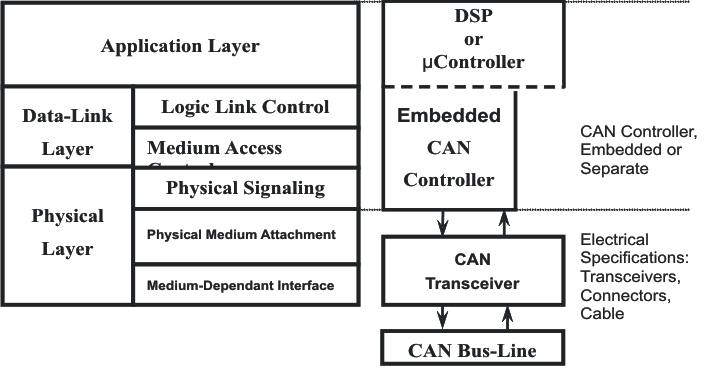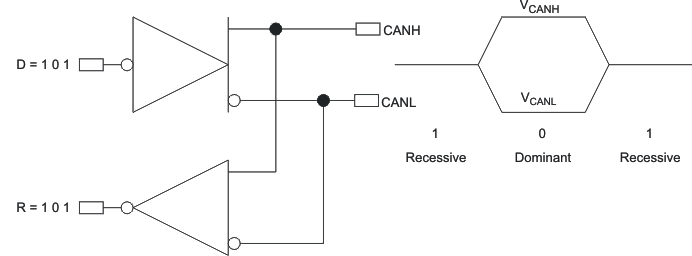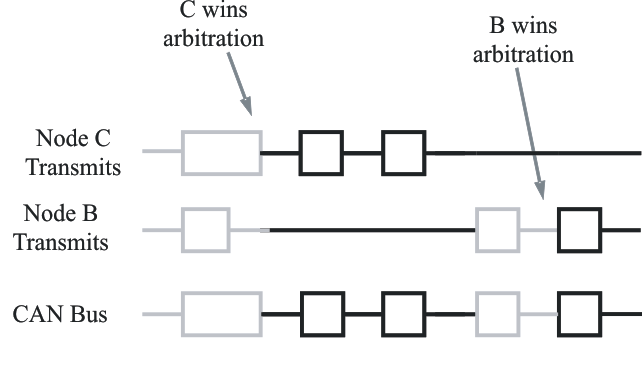-
Introduction to the Controller Area Network (CAN) SLOA101B August 2002 – May 2016 SN55HVD233-SEP , SN65HVDA1040A-Q1 , SN65HVDA1050A-Q1 , SN65HVDA540-5-Q1 , SN65HVDA540-Q1 , SN65HVDA541-5-Q1 , SN65HVDA541-Q1 , SN65HVDA542-5-Q1 , SN65HVDA542-Q1
-
Introduction to the Controller Area Network (CAN)
-
Introduction to the Controller Area Network (CAN)
- Trademarks
- 1 Introduction
- 2 The CAN Standard
- 3 Standard CAN or Extended CAN
- 4 A CAN Message
- 5
The CAN Bus
- 5.1
CAN Transceiver Features
- 5.1.1 3.3-V Supply Voltage
- 5.1.2 ESD Protection
- 5.1.3 Common-Mode Voltage Operating Range
- 5.1.4 Common-Mode Noise Rejection
- 5.1.5 Controlled Driver Output Transition Times
- 5.1.6 Low-Current Bus Monitor, Standby and Sleep Modes
- 5.1.7 Bus Pin Short-Circuit Protection
- 5.1.8 Thermal Shutdown Protection
- 5.1.9 Bus Input Impedance
- 5.1.10 Glitch-Free Power Up and Power Down
- 5.1.11 Unpowered Node Protection
- 5.1.12 Reference Voltage
- 5.1.13 V-Split
- 5.1.14 Loopback
- 5.1.15 Autobaud Loopback
- 5.2 CAN Transceiver Selection Guide
- 5.1
CAN Transceiver Features
- 6 Conclusion
- 7 Additional Reading
- Revision History
- IMPORTANT NOTICE
Introduction to the Controller Area Network (CAN)
Introduction to the Controller Area Network (CAN)
A controller area network (CAN) is ideally suited to the many high-level industrial protocols embracing CAN and ISO-11898:2003 as their physical layer. Its cost, performance, and upgradeability provide for tremendous flexibility in system design. This application report presents an introduction to the CAN fundamentals, operating principles, and the implementation of a basic CAN bus with TI's CAN transceivers and DSPs. The electrical layer requirements of a CAN bus are discussed along with the importance of the different features of a TI CAN transceiver.
Trademarks
CANopen is a trademark of CAN in Automation.
DeviceNet is a trademark of Open DeviceNet Vendor Association, Inc.
1 Introduction
The CAN bus was developed by BOSCH (1) as a multi-master, message broadcast system that specifies a maximum signaling rate of 1 megabit per second (bps). Unlike a traditional network such as USB or Ethernet, CAN does not send large blocks of data point-to-point from node A to node B under the supervision of a central bus master. In a CAN network, many short messages like temperature or RPM are broadcast to the entire network, which provides for data consistency in every node of the system.
Once CAN basics such as message format, message identifiers, and bit-wise arbitration -- a major benefit of the CAN signaling scheme are explained, a CAN bus implementation is examined, typical waveforms presented, and transceiver features examined.
2 The CAN Standard
CAN is an International Standardization Organization (ISO) defined serial communications bus originally developed for the automotive industry to replace the complex wiring harness with a two-wire bus. The specification calls for high immunity to electrical interference and the ability to self-diagnose and repair data errors. These features have led to CAN’s popularity in a variety of industries including building automation, medical, and manufacturing.
The CAN communications protocol, ISO-11898: 2003, describes how information is passed between devices on a network and conforms to the Open Systems Interconnection (OSI) model that is defined in terms of layers. Actual communication between devices connected by the physical medium is defined by the physical layer of the model. The ISO 11898 architecture defines the lowest two layers of the seven layer OSI/ISO model as the data-link layer and physical layer in Figure 1.
 Figure 1. The Layered ISO 11898 Standard Architecture
Figure 1. The Layered ISO 11898 Standard Architecture In Figure 1, the application layer establishes the communication link to an upper-level application specific protocol such as the vendor-independent CANopen™ protocol. This protocol is supported by the international users and manufacturers group, CAN in Automation (CiA). Additional CAN information is located at the CiA Web site, can-cia.de. Many protocols are dedicated to particular applications like industrial automation, diesel engines, or aviation. Other examples of industry-standard, CAN-based protocols are KVASER's CAN Kingdom and Rockwell Automation's DeviceNet™.
3 Standard CAN or Extended CAN
The CAN communication protocol is a carrier-sense, multiple-access protocol with collision detection and arbitration on message priority (CSMA/CD+AMP). CSMA means that each node on a bus must wait for a prescribed period of inactivity before attempting to send a message. CD+AMP means that collisions are resolved through a bit-wise arbitration, based on a preprogrammed priority of each message in the identifier field of a message. The higher priority identifier always wins bus access. That is, the last logic-high in the identifier keeps on transmitting because it is the highest priority. Since every node on a bus takes part in writing every bit "as it is being written," an arbitrating node knows if it placed the logic-high bit on the bus.
The ISO-11898:2003 Standard, with the standard 11-bit identifier, provides for signaling rates from 125 kbps to 1 Mbps. The standard was later amended with the “extended” 29-bit identifier. The standard 11-bit identifier field in Figure 2 provides for 211, or 2048 different message identifiers, whereas the extended 29-bit identifier in Figure 3 provides for 229, or 537 million identifiers.
3.1 The Bit Fields of Standard CAN and Extended CAN
3.1.1 Standard CAN
 Figure 2. Standard CAN: 11-Bit Identifier
Figure 2. Standard CAN: 11-Bit Identifier The meaning of the bit fields of Figure 2 are:
- SOF–The single dominant start of frame (SOF) bit marks the start of a message, and is used to synchronize the nodes on a bus after being idle.
- Identifier-The Standard CAN 11-bit identifier establishes the priority of the message. The lower the binary value, the higher its priority.
- RTR–The single remote transmission request (RTR) bit is dominant when information is required from another node. All nodes receive the request, but the identifier determines the specified node. The responding data is also received by all nodes and used by any node interested. In this way, all data being used in a system is uniform.
- IDE–A dominant single identifier extension (IDE) bit means that a standard CAN identifier with no extension is being transmitted.
- r0–Reserved bit (for possible use by future standard amendment).
- DLC–The 4-bit data length code (DLC) contains the number of bytes of data being transmitted.
- Data–Up to 64 bits of application data may be transmitted.
- CRC–The 16-bit (15 bits plus delimiter) cyclic redundancy check (CRC) contains the checksum (number of bits transmitted) of the preceding application data for error detection.
- ACK–Every node receiving an accurate message overwrites this recessive bit in the original message with a dominate bit, indicating an error-free message has been sent. Should a receiving node detect an error and leave this bit recessive, it discards the message and the sending node repeats the message after rearbitration. In this way, each node acknowledges (ACK) the integrity of its data. ACK is 2 bits, one is the acknowledgment bit and the second is a delimiter.
- EOF–This end-of-frame (EOF), 7-bit field marks the end of a CAN frame (message) and disables bit-stuffing, indicating a stuffing error when dominant. When 5 bits of the same logic level occur in succession during normal operation, a bit of the opposite logic level is stuffed into the data.
- IFS–This 7-bit interframe space (IFS) contains the time required by the controller to move a correctly received frame to its proper position in a message buffer area.
3.1.2 Extended CAN
 Figure 3. Extended CAN: 29-Bit Identifier
Figure 3. Extended CAN: 29-Bit Identifier As shown in Figure 3, the Extended CAN message is the same as the Standard message with the addition of:
- SRR–The substitute remote request (SRR) bit replaces the RTR bit in the standard message location as a placeholder in the extended format.
- IDE–A recessive bit in the identifier extension (IDE) indicates that more identifier bits follow. The 18-bit extension follows IDE.
- r1–Following the RTR and r0 bits, an additional reserve bit has been included ahead of the DLC bit.
4 A CAN Message
4.1 Arbitration
A fundamental CAN characteristic shown in Figure 4 is the opposite logic state between the bus, and the driver input and receiver output. Normally, a logic-high is associated with a one, and a logic-low is associated with a zero - but not so on a CAN bus. This is why TI CAN transceivers have the driver input and receiver output pins passively pulled high internally, so that in the absence of any input, the device automatically defaults to a recessive bus state on all input and output pins.
 Figure 4. The Inverted Logic of a CAN Bus
Figure 4. The Inverted Logic of a CAN Bus Bus access is event-driven and takes place randomly. If two nodes try to occupy the bus simultaneously, access is implemented with a nondestructive, bit-wise arbitration. Nondestructive means that the node winning arbitration just continues on with the message, without the message being destroyed or corrupted by another node.
The allocation of priority to messages in the identifier is a feature of CAN that makes it particularly attractive for use within a real-time control environment. The lower the binary message identifier number, the higher its priority. An identifier consisting entirely of zeros is the highest priority message on a network because it holds the bus dominant the longest. Therefore, if two nodes begin to transmit simultaneously, the node that sends a last identifier bit as a zero (dominant) while the other nodes send a one (recessive) retains control of the CAN bus and goes on to complete its message. A dominant bit always overwrites a recessive bit on a CAN bus.
Note that a transmitting node constantly monitors each bit of its own transmission. This is the reason for the transceiver configuration of Figure 4 in which the CANH and CANL output pins of the driver are internally tied to the receiver's input. The propagation delay of a signal in the internal loop from the driver input to the receiver output is typically used as a qualitative measure of a CAN transceiver. This propagation delay is referred to as the loop time (tLOOP in a TI data sheet), but takes on varied nomenclature from vendor to vendor.
Figure 5 displays the CAN arbitration process that is handled automatically by a CAN controller. Because each node continuously monitors its own transmissions, as node B's recessive bit is overwritten by node C’s higher priority dominant bit, B detects that the bus state does not match the bit that it transmitted. Therefore, node B halts transmission while node C continues on with its message. Another attempt to transmit the message is made by node B once the bus is released by node C. This functionality is part of the ISO 11898 physical signaling layer, which means that it is contained entirely within the CAN controller and is completely transparent to a CAN user.
 Figure 5. Arbitration on a CAN Bus
Figure 5. Arbitration on a CAN Bus The allocation of message priority is up to a system designer, but industry groups mutually agree on the significance of certain messages. For example, a manufacturer of motor drives may specify that message 0010 is a winding current feedback signal from a motor on a CAN network and that 0011 is the tachometer speed. Because 0010 has the lowest binary identifier, messages relating to current values always have a higher priority on the bus than those concerned with tachometer readings.
In the case of DeviceNet™, devices from many manufacturers such as proximity switches and temperature sensors can be incorporated into the same system. Because the messages generated by DeviceNet sensors have been predefined by their professional association, the Open DeviceNet Vendors Association (ODVA), a certain message always relates to the specific type of sensor such as temperature, regardless of the actual manufacturer.
4.2.1 The Data Frame
The data frame is the most common message type, and comprises the Arbitration Field, the Data Field, the CRC Field, and the Acknowledgment Field. The Arbitration Field contains an 11-bit identifier in Figure 2 and the RTR bit, which is dominant for data frames. In Figure 3, it contains the 29-bit identifier and the RTR bit. Next is the Data Field which contains zero to eight bytes of data, and the CRC Field which contains the 16-bit checksum used for error detection. Last is the Acknowledgment Field.
4.2.2 The Remote Frame
The intended purpose of the remote frame is to solicit the transmission of data from another node. The remote frame is similar to the data frame, with two important differences. First, this type of message is explicitly marked as a remote frame by a recessive RTR bit in the arbitration field, and secondly, there is no data.
4.2.3 The Error Frame
The error frame is a special message that violates the formatting rules of a CAN message. It is transmitted when a node detects an error in a message, and causes all other nodes in the network to send an error frame as well. The original transmitter then automatically retransmits the message. An elaborate system of error counters in the CAN controller ensures that a node cannot tie up a bus by repeatedly transmitting error frames.